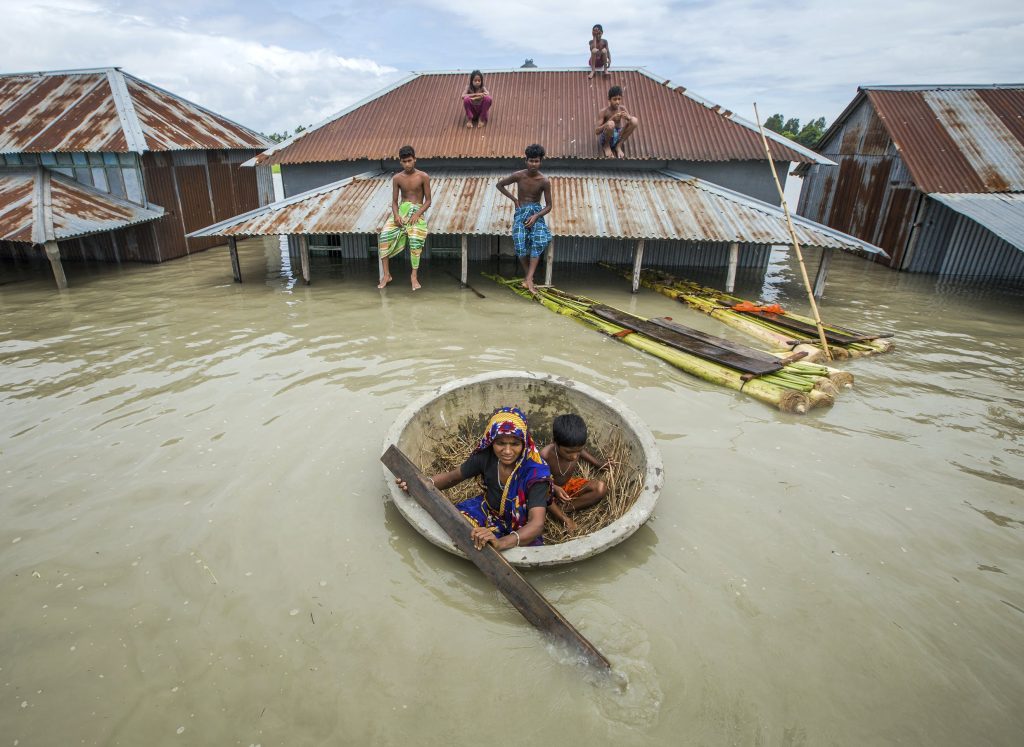
a woman and boy paddle away from their dwelling in Bangladesh after a river flooded their metropolis. picture: Moniruzzaman Sazal / local climate Visuals Countdown
the latest report from the Intergovernmental Panel on local climate Change (IPCC), the United Nations’ chief local climate science physique, confirms that we aren’t on monitor to safe a local climate-resilient, livable future. It presents basically the most in-depth evaluation but of the impacts of local climate change, our vulnerabilities to it, and our efforts to adapt to this point. maintain studying for our local climate consultants’ key takeaways on simply a few of the report’s most very important — and sobering — findings in a quantity of important areas: local climate finance, oceans, meals, equity, metropolis areas, and governance.
principal Findings from the IPCC’s New local climate Report
This report, the second principal installment inside the IPCC’s current evaluation cycle, paints a somber picture of the widespread and extreme local climate impacts that our planet — and all of the people, animals, and completely different species who stay right here — are already experiencing. Not solely does the report confirm that local climate change has had an adversarial impression on billions of people throughout the globe — and none extra so than marginalized communities — however some species and ecosystems have suffered irreversible losses, particularly these people and pure methods affected by melting glaciers and rising sea ranges.
The report further finds that the world has not acted at anyplace shut to the tempo and scale wished to meaningfully adapt to current and future impacts of local climate change. whereas the report finds that adaptation efforts might even be terribly efficient in minimizing local climate-fueled impacts and damages, they do not appear to be being carried out shortly or extensively ample. The IPCC additionally outlines decisions for adaptation, underlining ecosystem-based mostly adaptation (EbA) particularly as a extremely impactful approach which will assist people and nature deal with the impacts of local climate change whereas additionally reducing current and future risk. (EbA is a set of strategies that use pure ecosystems, resembling restoring mangroves to shield coastal areas from storm surge, to each revenue nature and shield people.)
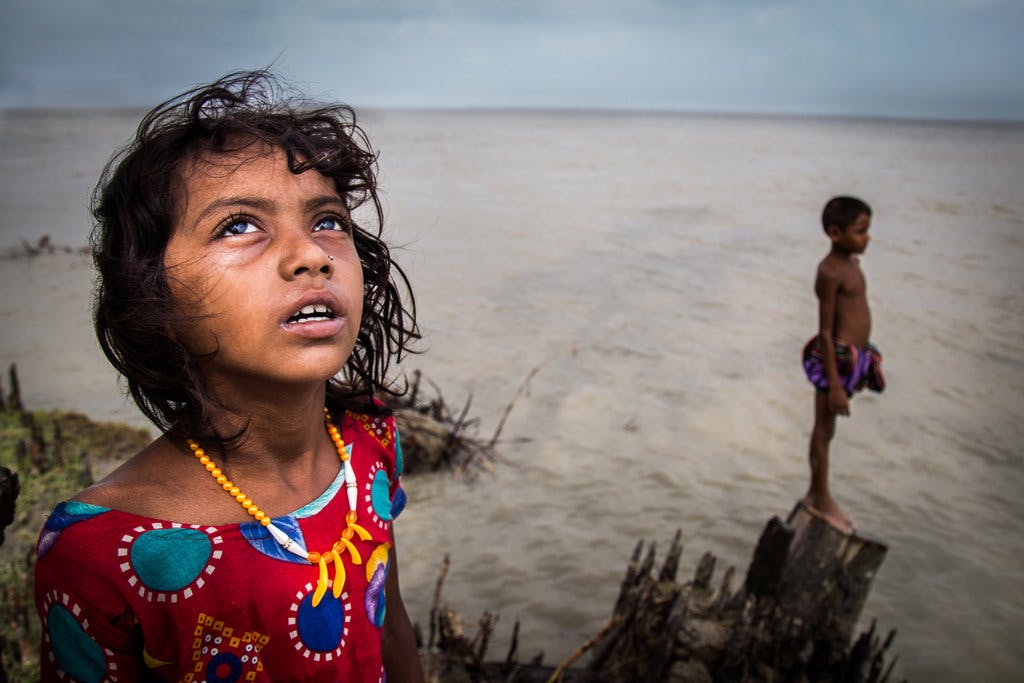
a woman and boy stand on a flooded riverbank in Bangladesh. picture: Moniruzzaman Sazal / local climate Visuals Countdown
This report additionally accommodates regional chapters for the principal time, and the IPCC produced accompanying regional fact sheets to current people rather extra devices to understand how the local climate is affecting their nook of the world. The science on this report has implications for all of the pure world, from particular person species to complete ecosystems. Our local climate consultants have unpacked a quantity of of the important factor findings for local climate finance, oceans, meals, equity, metropolis areas, and governance and lay out what we’re in a place to — and should — do in gentle of their implications.
the variation Finance hole
The findings: The discrepancy between obtainable local climate finance and projected local climate prices is rising. the quantity and variety of finance presently obtainable to adapt at pace and scale to local climate impacts is a lot decrease than what’s required to avert catastrophic damages, with basically the most susceptible populations at biggest risk.
The implications: whereas it’s clear there are a quantity of actions we’re in a place to take to adapt to and decrease vulnerability to local climate impacts, strategy extra can and want to be carried out. each the private and non-private sectors have important roles to play, although inside the case of adaptation, public funding is very important as a outcome of the shut to-time period alternatives for return on private sector funding in adaptation initiatives are extra sturdy to grab and thus typically don’t materialize. it is, as an event, far simpler to grab alternatives for private funding in new photo voltaic power, which is ready to generate regular shopper demand (and as a consequence of this fact returns) than, for event, funding in restoration of a mangrove forest which will current a very very important buffer to storm surges however doesn’t have paying clients to current returns.
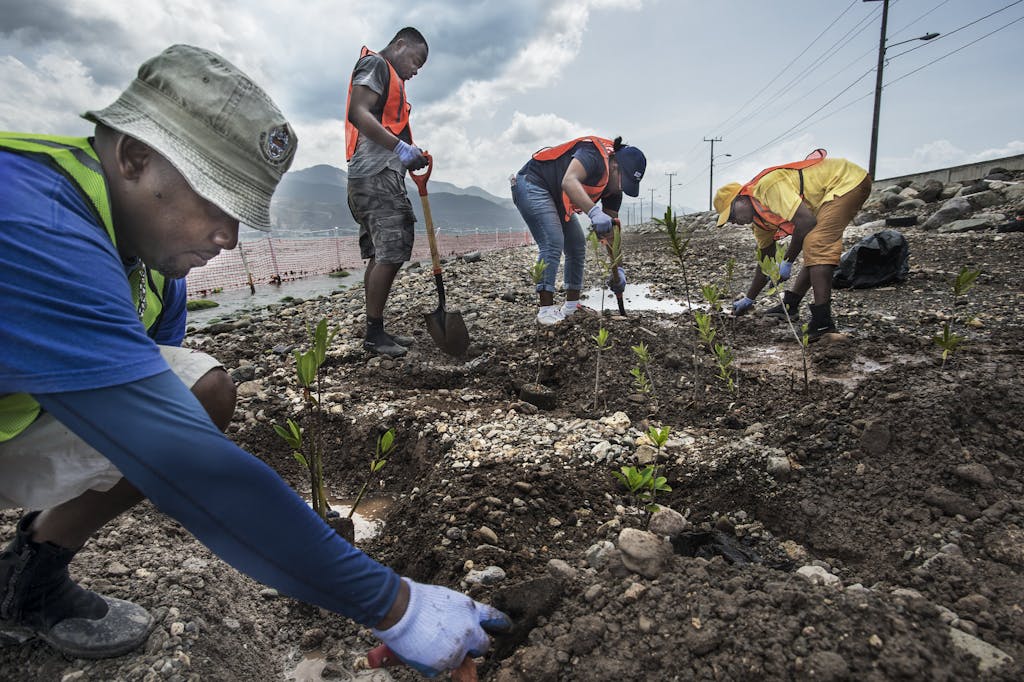
Mangroves from the nursery on the college of the West Indies being planted shut to Kingston, Jamaica. picture: UNEP
The response: now we want to unlock and scale up public sector funding in areas which would possibly be in important want of adaptation, using each direct public funding and nationwide and worldwide progress banks. we’re in a place to additionally develop new methods of driving elevated private sector funding.
For extra information, see the report’s Chapter 17: decision-making decisions for managing risk
defending the Ocean
The findings: local climate change has had extreme and lasting impacts on the ocean, a lot of which is ready to persist for many years. Impacts embrace widespread and more and more irreversible destruction of marine ecosystems. The ocean additionally faces extra intense tropical cyclones, extra speedy sea stage rise, and ocean acidification. Impacts to the ocean are anticipated to worsen. as an event, at 1.5°C of warming above preindustrial ranges, 70-ninety% of tropical coral reefs are anticipated to vanish; at 2°C of warming, over ninety nine% of coral reefs might even be gone.
The implications: each coastal communities and marine ecosystems will face irreversible impacts from local climate change, collectively with lack of coastal habitats, ecosystems, and infrastructure. Warming and ocean acidification have already negatively affected water, power, meals, and weight loss plan safety. prolonged-time period risks from sea stage rise for coastal ecosystems, people, and infrastructure are anticipated to enhance considerably.
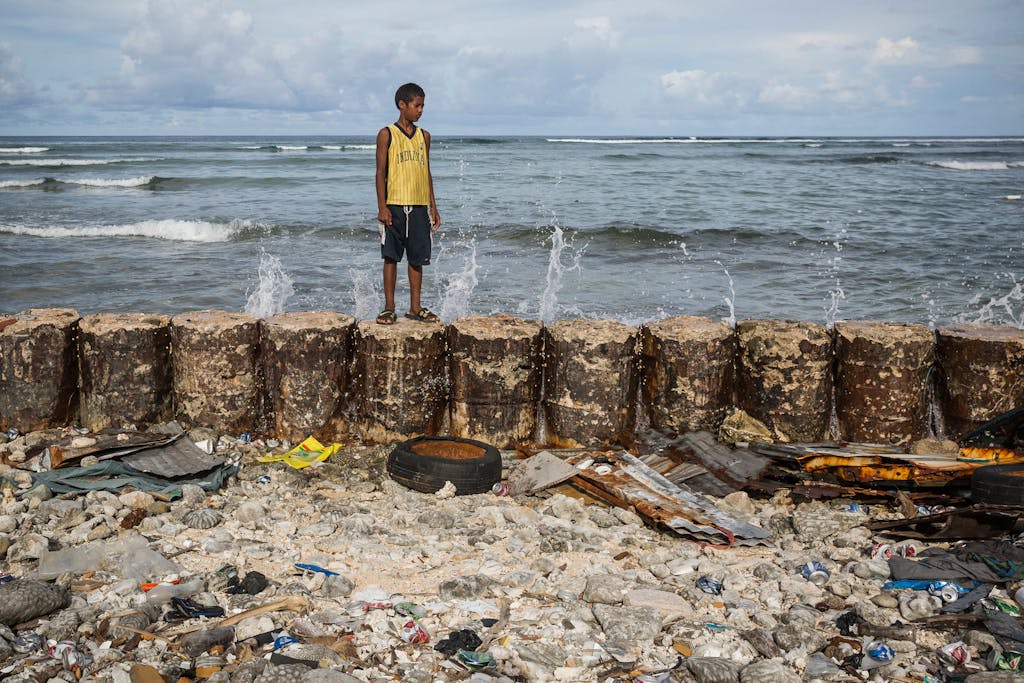
A teenage boy stands on a seawall that protects his household dwelling from the rising seas in Jenrock village inside the Majuro Atoll inside the Marshall Islands. picture: Vlad Sokhin/ UNICEF
The response: Governments should act shortly to implement insurance coverage policies that restrict warming to 1.5°C in an effort to restrict the severity of local climate impacts on the ocean and on the people and communities that rely upon it. collectively with slicing emissions, governments should act now to rearrange for sea stage rise, ocean acidification, and completely different impacts which will proceed for many years. Such measures embrace making sure that future coastal progress and infrastructure planning account for rising sea ranges and extra frequent climate occasions.
For extra information, see the report’s Chapter three: Ocean and coastal ecosystems and their companies
Resilient meals methods
The findings: warmth waves, droughts, floods, and ocean acidification threaten the meals safety and weight loss plan of 1000’s and 1000’s of people, notably in Africa, Asia, Central and South America, and small islands. inside the tip, intensifying local climate change impacts will put rather extra strain on meals manufacturing methods, further undermining meals safety.
Efforts required for meals methods to adapt to local climate change have a greater probability of success if carried out contained in the subsequent 10 years. Peril to worldwide meals and agriculture methods will sharply enhance as temperatures rise, with clear adaptation limits. At 2°C of warming, as an event, a quantity of staple crops in tropical areas will not be succesful to adapt as effectively as they do now. in the meantime, at 2°C of warming, extra people in Africa, Asia, Central America, and small islands are inclined to expertise malnutrition, and after 2050, if emissions proceed unchecked, meals availability will decline as a consequence of potential widespread crop failure and decreased fisheries and livestock.
The implications: with out significant adaptation efforts inside the agricultural sector, the impacts of local climate change on meals methods will jeopardize the achievement of Sustainable progress purpose (SDG) 2: Zero hunger and would possibly lead to cascading impacts on human well being, weight loss plan, livelihoods, and economies.
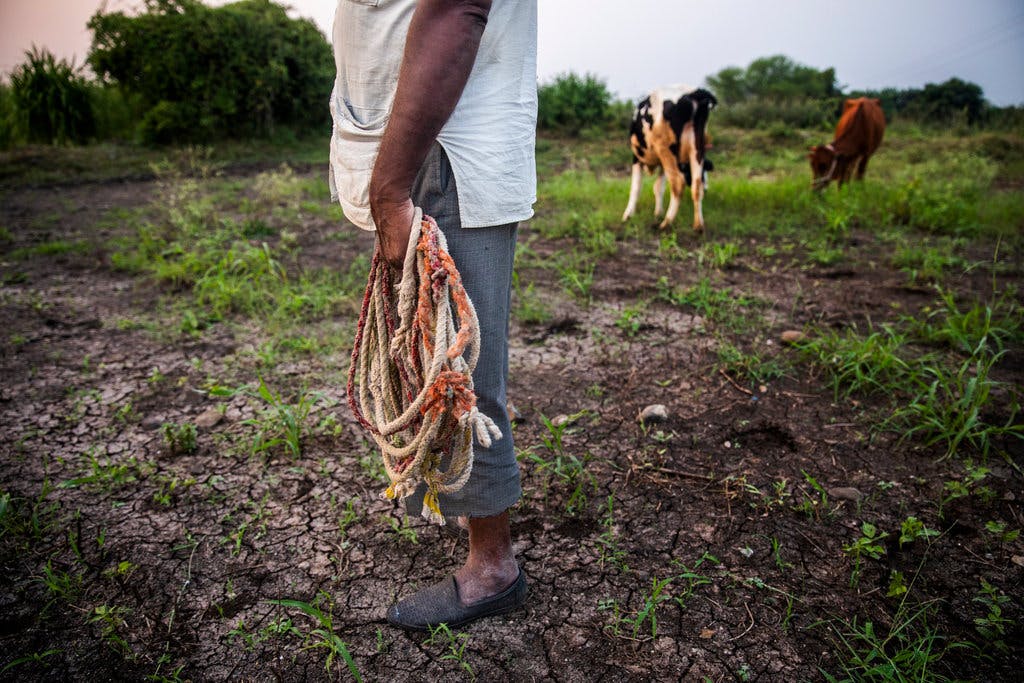
A farmer tends to his cows all by means of a second of warmth stress in India. picture: Prashanth Vishwanathan / Ashden
The response: a unfold of meals system adaptation and resilience decisions is out there, and loads of current strategies, resembling conservation agriculture and agroforestry, would ship vital advantages for nature. Policymakers ought to place money into making meals methods extra resilient by adopting stress-tolerant crops and livestock; diversifying farms; using nature’s personal options for pest administration, pollination, and storing carbon; and deploying completely different strategies. Such efforts might assist bolster the resilience of our meals safety, weight loss plan, livelihoods, properly-being, and biodiversity.
For extra information, see the report’s Chapter 5: meals, fibre, and completely different ecosystem merchandise
Addressing and Reversing Inequalities in susceptible Communities
The findings: susceptible teams — women, youths, ethnic minorities, Indigenous peoples, refugees — are experiencing, and would possibly proceed to expertise, disproportionate publicity and impacts from local climate change. people who discover themselves already marginalized and ceaselessly much less in a place to entry assets and assist are at better risk from local climate change. Vulnerability ensuing from inequality and poverty presents vital adaptation limits for Indigenous peoples particularly, as their livelihoods and cultures are typically inextricably tied with the land and ecosystems the place they stay.
The implications: Indigenous people and completely different susceptible teams will face extra hurdles when dealing with future local climate shocks. What’s extra, the impacts to these communities at simply 1.1°C above preindustrial ranges are projected to worsen as a outcome of the planet continues to warmth. Marginalized teams are most in hazard, collectively with coastal communities in growing economies whose livelihoods are threatened by rising seas.

An indigenous man smiles inside the Apiwtxa village, inside the course of the Brazilian Amazon rainforest. picture: Alécio Cézar/ UNICEF
The response: It’s crucial that nationwide policymakers and worldwide institutions dedicate assets to susceptible teams to deal with local climate change, collectively with a deal with stopping future disproportionate impacts on Indigenous peoples and completely different marginalized communities. this would possibly start with the $a hundred billion per yr in local climate finance that rich nations have prolonged promised however not but delivered to growing economies. furthermore it is important for local climate risk administration processes and outcomes to draw on Indigenous information and native information methods. The world’s leaders want to collaborate with susceptible teams to deal with current impacts and forestall future local climate risks which would possibly be distinctive to their wants and circumstances.
For extra information, see the report’s Chapter eight: Poverty, livelihoods and sustainable progress
constructing local climate-resilient Cities
The findings: metropolis areas, collectively with cities and informal settlements, are particularly inclined to local climate change. Billions of people in metropolis areas are uncovered to local climate risks, and adversarial impacts are anticipated to enhance inside the tip, as a outcome of the worldwide metropolis inhabitants is predicted to develop by 2.5 billion by 2050. What’s extra, by 2050 it is anticipated that over a billion people in low-mendacity metropolis areas shall be in hazard from coastal local climate hazards.
whereas metropolis areas are experiencing unfavourable outcomes of local climate change, additionally they signify a novel alternative for adaptation to a altering local climate. Implementing insurance coverage policies that strengthen ecosystem-based mostly adaptation approaches, resilient infrastructure, and equitable progress might assist obtain local climate-resilient cities.
The implications: metropolis areas signify each an infinite risk and a vital alternative the place local climate change is anxious. If current metropolis progress patterns persist (resembling a outcome of the construct-out of low-mendacity roads in flood inclined coastal areas and completely different local climate-susceptible infrastructure), extra people shall be uncovered to local climate risks as metropolis populations develop. What’s extra, the people who shall be most in hazard are people who are already economically and socially marginalized, resembling people residing in informal settlements.
Alternatively, local climate-resilient metropolis progress presents a quantity of advantages. as an event, promoting clear power, investing in metropolis transit methods, and rising entry to well being care can produce constructive outcomes for every the local climate and human well being, whereas enhancing entry to wash power and water might assist decrease again poverty and enhance people’s resilience to local climate impacts. These steps can shield billions of people — to not level out trillions of dollars’ worth of important infrastructure — from local climate change impacts. as properly as, local climate-resilient progress in metropolis areas advantages human well being, equity, and properly-being, whereas additionally defending the pure methods that border and work together with human settlements.

The skyline of San Francisco glows purple as a consequence of wildfires burning inside the Pacific Northwest of the usa. picture: Patrick Perkins / local climate Visuals Countdown
The response: it is important for policymakers and concrete planners to quickly undertake and implement local climate-resilient progress plans. whereas a majority of current funding is directed at flood partitions and completely different onerous engineering initiatives, funding ought to as one other deal with using nature to bolster adaptation, resembling metropolis agriculture and river restoration.
it is vitally very important give particular consideration to coastal cities in growing economies. they’ve amongst the diversified highest publicity to local climate change risks as a outcome of their local climate vulnerability is compounded by financial and social marginalization, even whereas they’ve the fewest assets to adapt to these risks. modern sources of private and non-private finance want to be made obtainable for metropolis governments and their companions in growing economies to allow them to implement local climate-resilient progress, particularly in massive coastal cities.
For extra information, see the report’s Chapter 6: Cities, settlements and key infrastructure and Chapter 18: local climate resilient progress pathways
Inclusive local climate Governance
The findings: Governance challenges can hinder sustainable progress and restrict adaptation potential. as properly as, all by means of the place inside the world, inclusive governance is important for implementing efficient local climate risk administration, adaptation, and local climate-resilient progress.
The implications: current governance and diplomacy efforts will not be ample to in the discount of current local climate change impacts and maintain away from future local climate risks. Adaptation efforts beneath current governance buildings might lead to so-referred to as maladaptation (adaptation efforts that actually worsen the situation), inflicting further damage to the environment and human society. To maintain away from maladaptation and guarantee efficient adaptation at scale, all kinds of societal actors and views want to be included inside the diversified governance arenas the place progress selections are made.
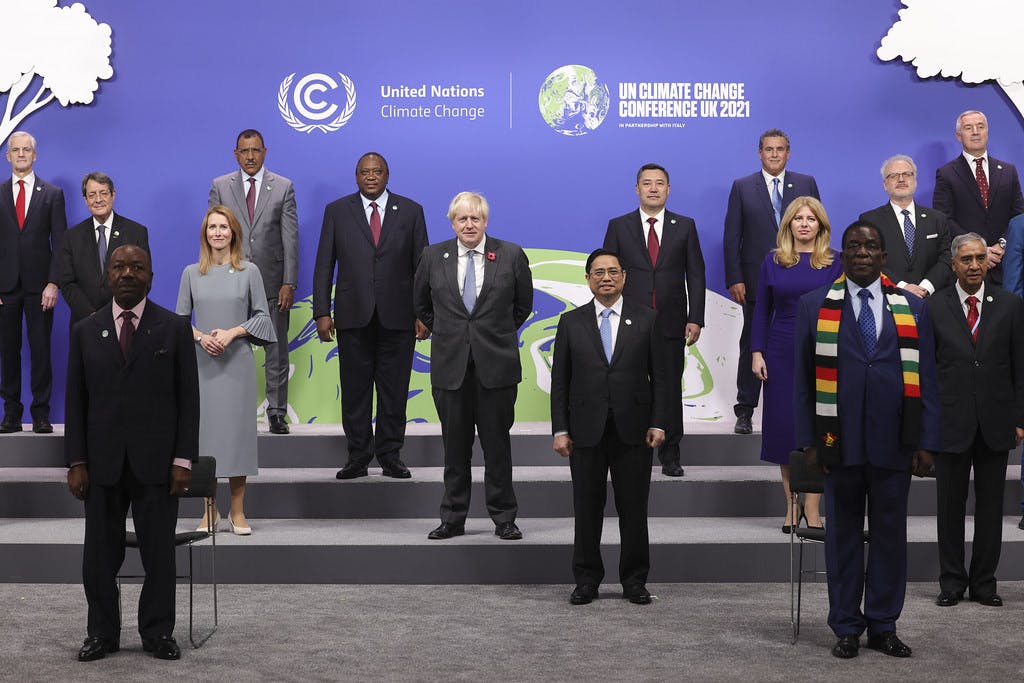
World leaders attend the COP26 World chief Summit—which aimed to increase commitments in the direction of mitigating local climate change. picture: Andrew Parsons / No 10 Downing road
The response: To pace up and strengthen adaptation efforts, governments should decrease governance boundaries by instituting inclusive frameworks, insurance coverage policies, and plans. These processes want to set adaptation targets, outline obligations and commitments, coordinate amongst actors and governance ranges, and construct adaptive performance. Governments should additionally mobilize monetary and technical assets and prioritize equity and justice in adaptation planning and implementation. Governments in any respect ranges should work in partnership with civil society, the youth movement, Indigenous peoples, native communities, ethnic minorities, educational institutions, media, retailers, and companies. Engagement with all stakeholders is required to create inclusive governance frameworks and develop efficient adaptation actions.
For extra information, see the report’s Chapter 17: decision-making decisions for managing risk
So what now?
This IPCC report has large relevance to all people from nationwide governments to native leaders, from the world’s wealthiest international areas to the poorest, and from the private sector to nonprofits and educational institutions. And whereas this report focuses closely on the impacts of local climate change, it additionally highlights options to deal with the immense challenges we face. the subsequent IPCC report, which is ready to deal with local climate change mitigation, is predicted to be launched in early April, and it will place an glorious better emphasis on local climate change options.
the options leaders make over the subsequent 10 years will decide the planet’s future. And whereas the science is unequivocal that now we haven’t bought any time to waste, the good information is that all of us know what now we want to do. there are options to the local climate disaster, and this latest report from the IPCC confirms that now we want to quickly scale up adaptation and make deep emissions cuts to protect the rise in worldwide temperature in confirm. We face a quickly closing window to safe a livable future — and we should act now.
For extra particulars with reference to the IPCC, see our weblog posts beneath previewing the variation and mitigation studies and our piece with reference to the August 2021 science report.

